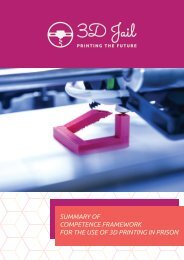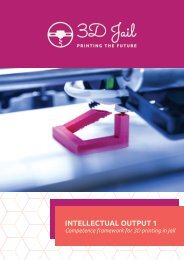Training models for the use of 3D printing technology in prison
3D Jail project further involves a training program for the training and development of trainers who are going to deliver the training program for inmates. Trainers are required to have basic computer, CAM and CAD skills. For the training of the trainers has also been planned an in-service training program to cover information on general characteristics of penitentiary institutions and inmates, use of the e-learning portal, and 3D printing.
3D Jail project further involves a training program for the training and development of trainers who
are going to deliver the training program for inmates. Trainers are required to have basic computer,
CAM and CAD skills. For the training of the trainers has also been planned an in-service training
program to cover information on general characteristics of penitentiary institutions and inmates, use
of the e-learning portal, and 3D printing.
Create successful ePaper yourself
Turn your PDF publications into a flip-book with our unique Google optimized e-Paper software.
Mobile device vendors providing educational technology in prisons
Although prison education programs have a long history of working with vendors (e.g., software
vendors), a growing number of mobile device vendors have moved into the prison education market.
These vendors are adopting one or more of the existing approaches described above to equip
corrections facilities with tablets or other devices for use in and outside of the classroom. Some of
these vendors are focused primarily on providing education content and e-book readers while others
are focused on expanding commissary services beyond typical products such as hygiene items, snacks,
clothing, and entertainment devices and content (e.g., movies and music). In fact, most of these
vendors entered the prison education market as commissary providers and adapted their services as
the demand for educational technology increased. These providers contract with individual countries
to provide commissary services and then, as part of their contract, can market computing devices with
educational content to incarcerated individuals (and their families) for individual study or for use in
the correctional education program.
Some vendors have entered prison education through the communications market. These vendors
have developed secure network channels for facility phone and video conferencing that also can be
used to provide educational content on mobile devices. Other vendors have started working with
prison education programs based on their knowledge of providing technology-based educational
programming in conventional K-12 and postsecondary classrooms.
Regardless of their origins, these vendors typically attain educational content for their mobile devices
in one of two ways:
●
●
through direct download or “mirroring” of Open Educational Recources (OERs) available
online; this can require establishing agreements to provide hard copies of online content and
recreating online resources in an offline environment.
through licensed reseller agreements with established educational publishers, vocational
training service providers, and other companies and organizations offering targeted reentry
resources.
In addition to mobile device vendors, other vendors of advanced technologies are entering the market.
For example, Google’s Government Solutions Division is exploring ways in which ChromeBooks and
Chrome Management Console can be used to facilitate secure Internet- based learning options for
prison facilities. Google is either currently in classrooms, or in the rollout phase of projects, in prisons.
Google’s approach differs from the tablet-focused programs in that Google partners with providers
like Dell and Samsung to manufacture devices, but it is not in the business of selling hardware.
International use of technology in correctional education delivery
A number of governments — including the United Kingdom, Australia, and New Zealand — are
exploring and implementing prison education initiatives. Like those in the European Union, they are
intended to provide incarcerated individuals with access to technology-based education and career
resources to promote successful re-entry (also referred to as “reintegration” and “resettlement”).
These countries provide a good comparison for the European Union because of similarities in their
cultures, politics, and education and prison systems.
3DJail printing the future – IO2
8





